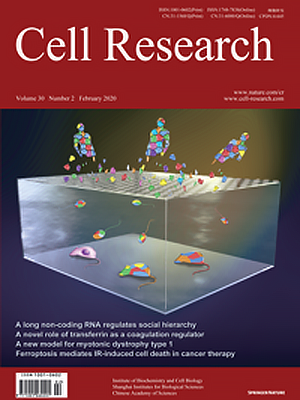
Volume 30, No 2, Feb 2020
ISSN: 1001-0602
EISSN: 1748-7838 2018
impact factor 17.848*
(Clarivate Analytics, 2019)
Volume 30 Issue 2, February 2020: 146-162
ORIGINAL ARTICLES
The role of ferroptosis in ionizing radiation-induced cell death and tumor suppression
Guang Lei 1,2,3 , Yilei Zhang 2, Pranavi Koppula 2,4 , Xiaoguang Liu2, Jie Zhang2, Steven H. Lin 2,5 , Jaffer A. Ajani6, Qin Xiao 1,3 ,Zhongxing Liao5, Hui Wang 1,3 and Boyi Gan 2,4
1 Department of Radiation Oncology, Hunan Cancer Hospital and The Affiliated Cancer Hospital of Xiangya School Of Medicine, Central South University, Changsha, Hunan 410013, China; 2Department of Experimental Radiation Oncology, The University of Texas MD Anderson Cancer Center, Houston, TX 77030, USA; 3Key Laboratory of Translational Radiation Oncology, Hunan Province, Changsha, Hunan 410013, China; 4The University of Texas MD Anderson Cancer Center UTHealth Graduate School of Biomedical Sciences, Houston, TX 77030, USA; 5Department of Radiation Oncology, Division of Radiation Oncology, The University of Texas MD Anderson Cencer Center, Houston, TX 77030, USA and 6Department of Gastrointestinal Medical Oncology, Division of Cancer Medicine, The University of Texas MD Anderson Cancer Center, Houston, TX 77030, USA
Correspondence: Hui Wang (wanghui@hnszlyy.com) or Boyi Gan (bgan@mdanderson.org)These authors contributed equally: Guang Lei, Yilei ZhangFurther information and requests for reagents should be directed to the lead contact, Boyi Gan (bgan@mdanderson.org).
Ferroptosis, a form of regulated cell death caused by lipid peroxidation, was recently identified as a natural tumor suppression mechanism. Here, we show that ionizing radiation (IR) induces ferroptosis in cancer cells. Mechanistically, IR induces not only reactive oxygen species (ROS) but also the expression of ACSL4, a lipid metabolism enzyme required for ferroptosis, resulting in elevated lipid peroxidation and ferroptosis. ACSL4 ablation largely abolishes IR-induced ferroptosis and promotes radioresistance. IR also induces the expression of ferroptosis inhibitors, including SLC7A11 and GPX4, as an adaptive response. IR- or KEAP1 deficiency-induced SLC7A11 expression promotes radioresistance through inhibiting ferroptosis. Inactivating SLC7A11 or GPX4 with ferroptosis inducers (FINs) sensitizes radioresistant cancer cells and xenograft tumors to IR. Furthermore, radiotherapy induces ferroptosis in cancer patients, and increased ferroptosis correlates with better response and longer survival to radiotherapy in cancer patients. Our study reveals a previously unrecognized link between IR and ferroptosis and indicates that further exploration of the combination of radiotherapy and FINs in cancer treatment is warranted.
https://doi.org/10.1038/s41422-019-0263-3
FULL TEXT | PDF
Browse 1041


